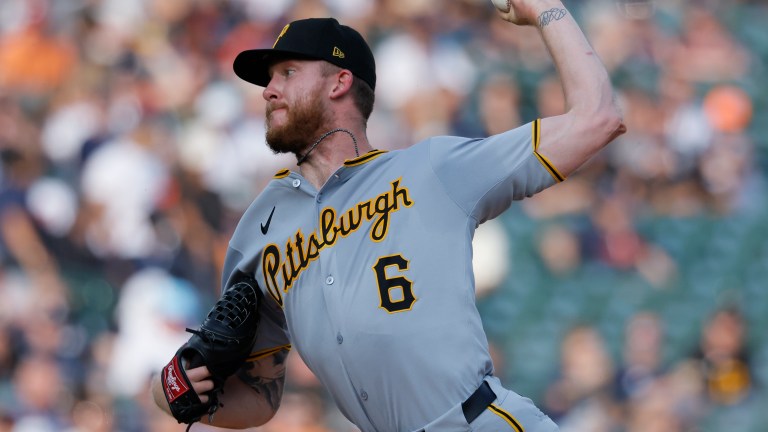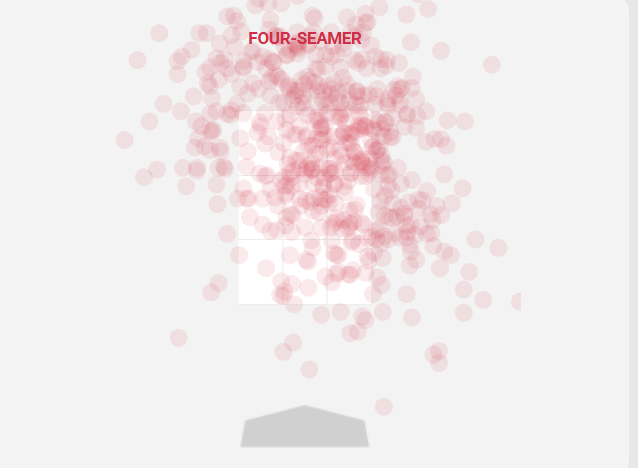Why Bailey Falter is the Pirates’ Best Trade Chip
The Pittsburgh Pirates have a lot of pitching they could potentially sell at the deadline, but Bailey Falter may just top the list.

When examining the Pittsburgh Pirates as a team, it’s easy to see one clear theme that truly captures their 2025 season: This year has been a massive disappointment, and far from what they had hoped it would be. As of June 28th, the team currently sits at 33-50, a record that stands only above the Colorado Rockies in the National League.
With the Pirates’ pitching staff being the main positive takeaway for this team, it’s also become clear that they need to make offensive additions quickly to have a chance of succeeding in the Skenes era. Starting pitchers of this caliber don’t come around often, and the Pirates must capitalize on his presence on the team.
The easiest way to boost their offense would be through the MLB Draft, but with this year being one of the more top-heavy classes in recent memory, it will be challenging to find pieces to impact the team quickly. Not only this, but the Pirates have focused so heavily on pitching in the Ben Cherington era that the team has almost no offense weapons coming to help them.
This leaves the Pirates with another route to success: The trade deadline.
With this deadline currently set to be one of the least impactful we’ve seen in a while, with few big pieces available, the Pirates could do very well selling off some of their pieces. Many players could make sense to sell off, but the main name who stands above the rest is left-hander Bailey Falter.
Why is Falter the player who stands above the rest? What makes him so valuable? Let’s take a closer look at his trade candidacy and why he makes the most sense for the Bucs to move this July.
Breaking Down Falter’s Career Year
The 2025 season marks the second full season Falter has spent with the Pirates, as he was dealt to the club for Rodolfo Castro during the 2023 trade deadline. His reputation across these two-and-a-half seasons has always been as a stable innings eater, yet the 2025 season has looked much different for him.
So far this year, Falter has pitched 85.1 innings across 16 starts, where he’s maintained a career-best ERA of 3.59 alongside an ERA+ of 118 and a WHIP of 1.18. He hasn’t been a super dominant strikeout threat, as he’s only struck out 51 batters in this same time frame. Yet, despite this, he’s still been a reliable starter who gets the job done.
The highlight of his season so far was his career-best month of May, where he recorded an ERA of just 0.76 across 35.2 innings, cementing himself as one of the better starters in the game during May.
He also only allowed three extra-base hits the entire month, while also posting the lowest ERA by a Pirates pitcher in the live ball era during a calendar month where they made six or more starts. Overall, he’s had some incredible highs this season.
What makes Falter so intriguing and interesting is the fact that his game is so simple, yet so effective. He doesn’t rank above the 60th percentile or better in any of Baseball Savant’s main categories outside of extension and barrel rate, with his extension being the lone elite part of his profile.
A big part of Falter’s dominance this season has been due to his five-pitch arsenal, which has played extremely well overall. He mixes in a four-seam fastball, slider, sinker, curveball, and a splitter, with all of these pitches playing a role in his success.
His main pitch is his four-seam fastball, which has an incredibly unique profile. Falter’s four-seamer has elite ride, as the pitch averages 18.7 IVB. While it has a lower horizontal break and velocity, Falter’s elite extension paired with his 55-degree arm slot creates an incredibly unique pitch with a ton of deception, making the pitch play far better than we’d expect.
This is especially true when Falter throws it in the top of the zone, which he’s done quite often this season.

His sinker is almost exactly like his four-seamer, just with a different classification. Between the two pitches, Falter has significantly positive run values, with hitters struggling to hit either pitch.
Falter’s slider plays more like a cutter, which gives it the ability to tunnel well off his fastball. It misses barrels, and Falter is able to use it to steal strikes on the back foot for right-handers while backdooring lefties. It also generated a whiff rate of nearly 26%, a pretty solid number.
The same can be said about his curveball, which is also used in relatively the same location as his slider. It’s thrown in the zone more than the league-average curveball, which can sometimes be concerning.
While we haven’t seen his splitter much this season, it could be a decent offering when tunneled with his fastball, which we already established as being successful due to his high vertical break. This type of tunnel has worked for other high-vert pitchers such as Shota Imanaga or Logan Gilbert.
Due to the uniqueness of his arsenal, Falter has been able to play far better than you’d expect on paper. There is still some concern for regression due to his low strikeout rates, quality of contact, and the type of pitcher Falter is. However, if he continues to maximize his arsenal to the best of its ability, I imagine he’ll continue to pitch well.
What Makes Him Such a Valuable Trade Asset?
When examining Falter a little closer, we see a few things that contribute to him being such a valuable trade asset. This is also the case for both the Pirates as well as the teams who could acquire Falter during the deadline.
For starters, Falter comes with an immense amount of team control compared to other pitchers who may be available on this year’s trade market. Falter is currently making just $2.222 million this season, as the Pirates avoided arbitration with him last offseason.
However, Falter will come with three more seasons of arbitration eligibility, meaning he’s under control until the end of the 2028 season. Most pitchers available on deadline day will likely have one or two years left on their contracts, making them far less valuable.
In addition to this, Falter will be far more affordable than most arms, given the current status of starting pitching contracts. Arms of Falter’s caliber typically make around $15-20 million, and with Falter being in arbitration, he still has plenty of time to go until he reaches this number.
On the Pirates’ side, now is the perfect opportunity to trade Bailey Falter. This is the best he’s ever pitched to this point in his career by a good margin, and his profile allows for a lot of potential regression at truly any moment.
As I mentioned earlier, while Falter’s profile is incredibly interesting and he uses it to the best of his ability, he lacks a quality that makes him a truly elite arm. There’s nothing that truly stands out about him as a pitcher, with many of his results spitting out below-league-average numbers. Keeping this in mind, he becomes more of a wild card than the other arms in their rotation.
Given this fact, Ben Cherington must take into consideration the risk and reward of trading Falter versus holding onto him. If he keeps him, there’s the possibility he regresses to what some of his underlying metrics indicate, and they missed out on landing a sizable haul in return for him.
If this happens after he’s been traded, the Pirates could be in a situation where they land a decent haul for a below-league-average starting pitcher.
At his current strengths, trading Falter would be a win-win scenario for every party involved. A competing team will likely be the one to trade for Falter at the deadline, and he’d immediately stand in as a solid piece in the back end of their rotation.
For the Pirates, they could add some decent future offensive weapons without sacrificing much, as they have plenty of starting pitching depth to replace him with as well.
What Could a Return Look Like?
The trickiest part in projecting a Bailey Falter trade would be examining what the return for Falter could look like. It’s rare to see a starting pitcher dealt with this much control, especially amid a career year. Also, it’ll be important to see how aggressive this year’s market is, as that could determine the package as well.
When examining recent trades that involved pitchers with a few years of control left, some comparisons can be found.
Last year, the Miami Marlins dealt lefty Trevor Rogers to the Baltimore Orioles, who was controllable until 2026, and they landed a pretty good haul in return.
The Orioles dealt Kyle Stowers and Connor Norby to the Marlins for Rogers. With both of these players being formally ranked highly in their farm system, this was a significant move.
However, Rogers had more success than Falter at the point of his trade, as he had already made an All-Star team and nearly won Rookie of the Year in 2021, while also putting together some decent seasons along the way.
Another decent example that comes to mind is when the Phillies acquired Jesus Luzardo and Paul McIntosh this offseason for Staryln Caba and Emaarion Boyd. Once again, Luzardo’s amount of control allowed the Marlins to land a decent prospect haul, as Caba is ranked on our top 100 prospects list.
However, just like Rogers, Luzardo had already put together a few seasons that were better than Falter’s 2025 campaign. This included a 200-strikeout season in 2023, where Luzardo recorded an ERA+ of 131 across 178.2 innings.
With both of these pitchers recording better seasons than Falter before being traded, it’s a little harder to find a direct comparison to gauge a potential return. However, it’s reasonable to assume the Pirates could land a few solid prospects, including potentially even a fringe top 100 prospect, depending on the demand for starting pitching at this year’s deadline.
Regardless of what the demand may be, the Pirates could land some significant offensive help by dealing Falter later next month. It’ll likely depend more on the demand for starting pitching at this year’s deadline, which has allowed teams to pull off very good returns in past years. Overall, only time will tell as to what his return could be.
One thing is for certain, though: Bailey Falter is the Pirates’ best trade piece, and trading him makes sense for both the buyer and seller.
